I’ve always been super fascinated with eclipses, especially solar ones. I had never had a chance to experience a total solar eclipse, which always made me sad. There was a big one nearby on June 30, 1992. I was 11 years old. Just a couple days before, I had a serious kidney failure and I got admitted to a hospital for two weeks. I was just 230 km from the totality zone and I missed it. I remember very well to have asked the nurses to watch the partial eclipse from a hospital window, but the day was overcast. 🙁 There was another one on November 3, 1994. I was 375 km from the totality zone, but I couldn’t go either. The day was perfect though and I watched the moon partially covering the sun from my school. I never forgot that moment. I had to wait 23 more years to see a big one.

I read about the “great American eclipse” when we were expecting Daniel. We were still living in Brazil without plans to move. When I checked the dates and realized Daniel would be 5 years old then, the mission was set. We would travel to Oregon on August 21, 2017, no matter what. I couldn’t miss the opportunity. Soon after, we moved to California, so the plan became a lot easier to be executed. At Facebook, we have an internal system where we register the dates we’ll be out of office, like for vacation, business trips, etc. I registered that date almost 5 years before. I was willing to quit my job (hmm maybe not) if anyone forced me to go to work that day.
I became obsessed about this eclipse. I read everything I could about it. The totality path would cross the entire country, so we had plenty of options where to go. Central Oregon was the best bet weather-wise, because it had the least likelihood for clouds in the summer. Also, it was the closest to California, so it’s easy.
Or so I thought.
One thing I hadn’t realized was that millions of other people were planning to do exactly the same. I tried to book hotels around 9 months before the eclipse, just to realize things had been sold out for years. Looking at the maps around central Oregon, it was clear there was no road infrastructure to support so many people going there. It was becoming evident that driving wouldn’t be a good idea if we didn’t find where to stay overnight.
Right around the time I was trying to plan this, I was moving along with my US pilots license. So things were aligning well, and I decided we were going to fly to see the eclipse, either from the air or from an airport in the totality path. There was one problem though. Committing myself to a long flight without being instrument-rated would be setting myself up for frustration. Any clouds on my way would ground me, so I had to unblock that deficiency before the eclipse.
I talked to my flight school that I would start my instrument training in March with the goal to be licensed in June. That’s crazy. Lots of pilots take years to accomplish that. However, it’s not that uncommon that people do it quickly, but it’s a big commitment. The learning curve is very steep, and the requirements are high. I didn’t care and I signed up for that. Between March and June, I spent an uncountable amount of hours studying, eating books, watching hours of videos, and flying a lot, like A LOT. I wasn’t in just for the license. I really wanted to learn this well, as this is super serious stuff. My instructors were fantastic and they accepted the challenge to make me ready for the exam in time. On June 13, 2017, I passed the FAA exam with flying colors. Now I was unblocked to fly through the clouds.
There was another problem though. Luana had to work on the day before the eclipse, so it would be quite complicated for us to depart on the Sunday August 20th. We decided to do everything on one day. That’s a lot of flying for one day, so I didn’t feel comfortable to do that all by myself. A few months before finishing my instrument rating, I made a conditional invitation to my great friend Alberto Bengoa, who’s also a pilot, and lives in Brazil. I invited him to spend some time with us and go with us to see the eclipse, with the condition that I passed the instrument exam. He accepted and arrived here just a couple days before. He had never flown a Cirrus before, so I flew to pick him up in Los Angeles, so he could get familiarized with the airplane before we launched for the main mission. I was not expecting him to actually fly the airplane, and so more to help with the cockpit duties and have another knowledgeable person onboard to cross check me.
We rented the best airplane we could possibly get, a 2017 brand-new Cirrus SR22T G6, fully loaded. I knew the skies would be crazy busy that day and there were lots of alerts for pilots to be super super careful with traffic. So I really wanted an airplane with the very best technology for traffic avoidance. That particular airplane has an active TCAS and ADS-B in/out, which is the best tech there is. This didn’t remove at all our responsibility to keep our eyes outside, but it immensely helps with situation awareness.
We got the airplane on the Sunday and we flew it a bit to make sure everything was working properly. We also moved the airplane from San Carlos to Hayward, that’s closer to home and a much better airport. We had also rented some fancy GoPros, so we mounted them all to cover all angles from the cockpit.
Timing for the flight on Monday was absolutely crucial. We had to be in the totality center path before 10:20am, otherwise the whole mission was failed. If there’s one thing in life that will never be late, it’s an eclipse. We didn’t have enough fuel to fly for 3 hours, watch the eclipse and fly back to an airport nearby, so we planned a fuel stop on the way, that was Klamath Falls, south Oregon. We had to take off in time to make a fuel stop, get fuel expecting lots of other airplanes having the same idea, take off again and arrive there in time.
We told the kids we would wake up and it would still be dark. They were pretty excited with this as well, so it was actually pretty easy. 4am we all woke up, ate something quickly and drove to the Hayward Airport. Alberto and I had made arrangements with the FBO to expect us by 5am. They were there as promised. We loaded everything onboard, double-checked everything on the airplane and filed our flight plan to Klamath Falls. That morning, the marine layer was all over the Bay Area. The sky was solid overcast with low clouds and there would be absolutely no way to fly visually in those conditions. We got our instrument clearance and we were airborne 5:58am, half an hour before the sunrise. A minute or so after we took off, we were completely soaked in the clouds. A minute or two more, we broke off on the top of the layer, with an absolutely beautiful dawn sky above us. Very easy flight. We landed there 7:44am, with plenty of time to get fuel, use the restroom, rest a bit and launch. While the fuel truck was servicing us, lots of other airplanes were landing. The fuel guy said they had never seen so much traffic, but they were prepared for the day.
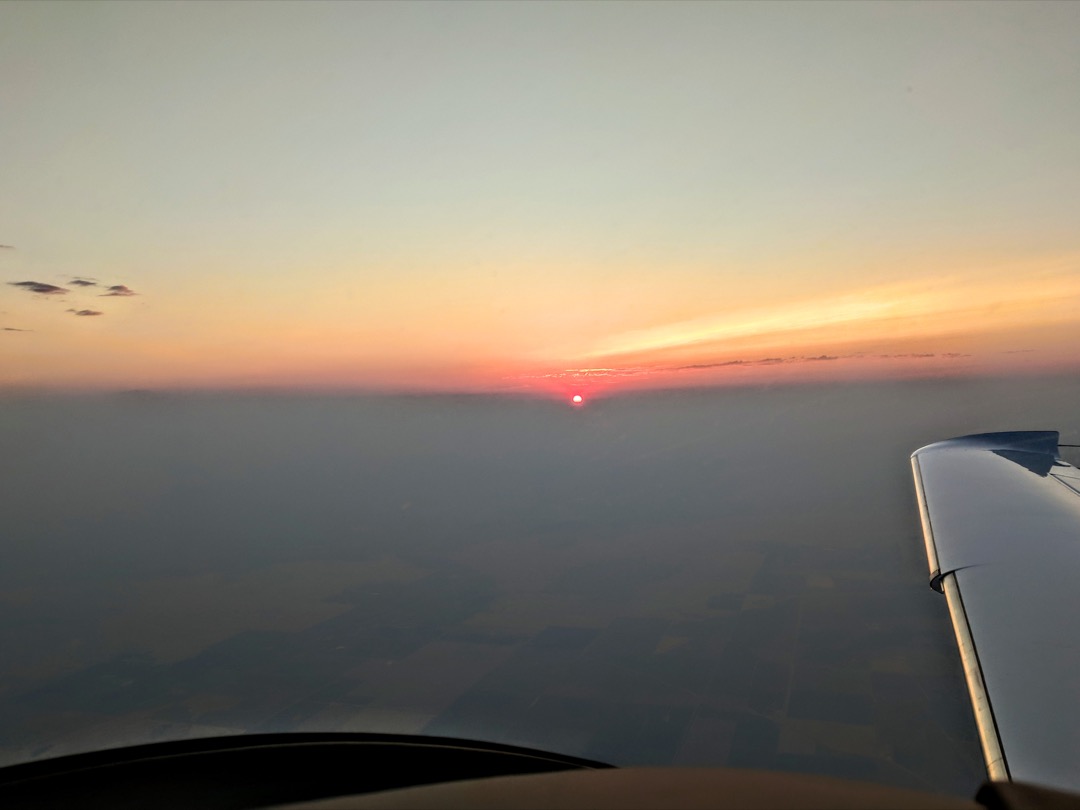
We were just one hour away from the totality center, so we didn’t want to take off too soon and get there too early. We would waste a lot of fuel flying in circles and we’d also be exposed to too much traffic for no reason. We took off from Klamath Falls 8:46am, about 1h34min before the total eclipse. We slowed the airplane down to get there a couple minutes before to minimize our exposure and fuel consumption. Initially, we had planned to fly north from Klamath Falls to Madras, but we saw in our traffic screens that the amount of traffic around Madras was just too insane, so we decided to fly farther east. In my iPad flight software (ForeFlight), I had a precise overlay of the eclipse path, and I also had the exact GPS coordinates of the center line in the flight management system of the airplane. We were equipped to navigate precisely to see the most of the eclipse. The problem with that is that excess of precision can contribute to accidents, as other airplanes have the same capability, so we decided to fly across the center line, instead of along with it, losing just a few seconds of totality. We had a big block of altitude to use, between 9000 and 12500 feet. We would decide to use the altitude that had the least amount of traffic in the area, so we ended up around 9600 feet the whole time, as most of the traffic was above us.
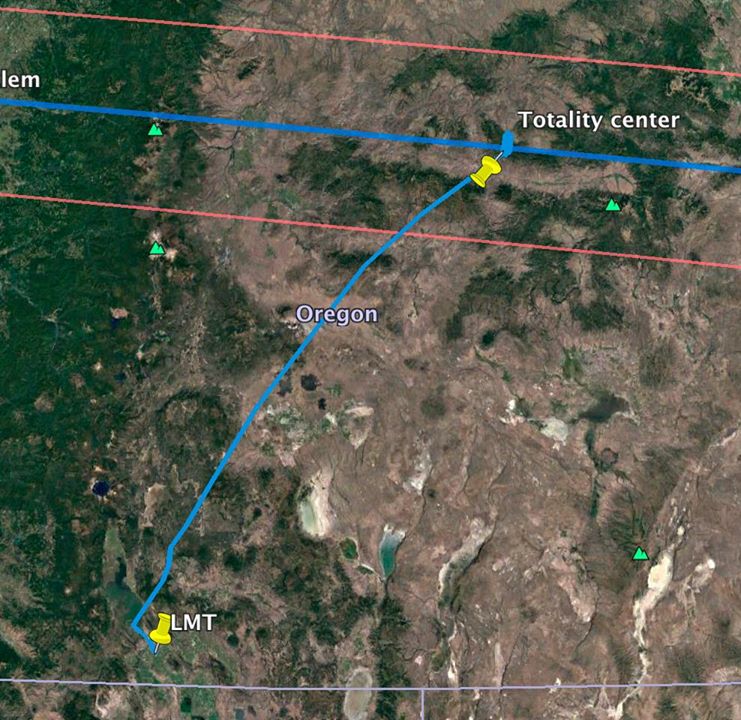
We crossed the totality center line 9:57am, about 23 minutes before the show. I was super happy that we had arrived at the right place, the weather was beautiful and I wouldn’t miss this magnificent thing another time. We put the plane in an automatic holding pattern across the center line and waited, paying serious attention to traffic. The sky was getting darker and darker. Absolutely surreal.
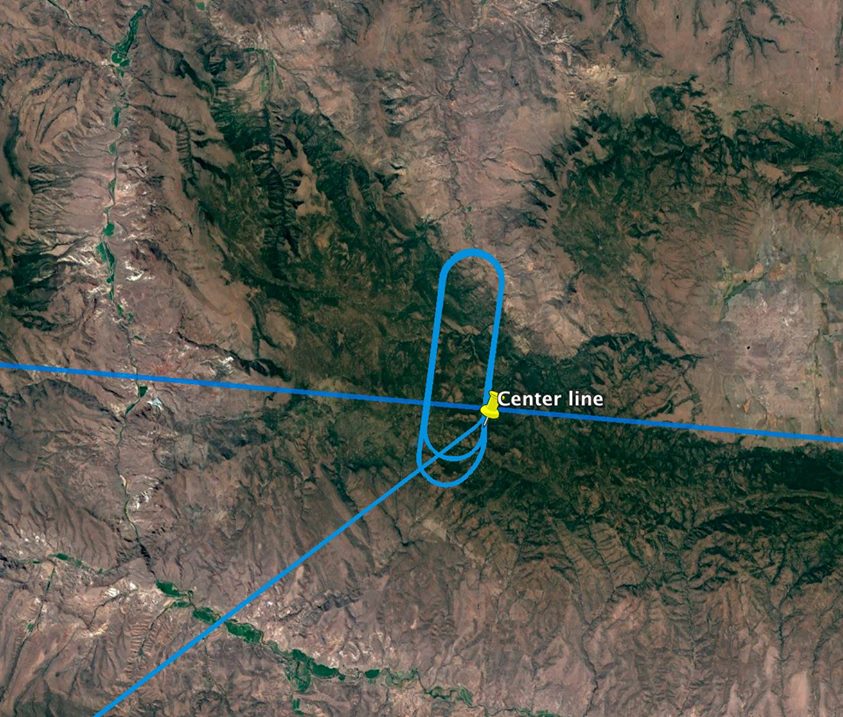
It was awesome to see both Daniel and Douglas really enjoying the experience, seeing the moon taking a bit bite on the sun through the eclipse glasses. We thought Douglas wouldn’t give a shit about this, and we were very wrong. They talked about this several weeks after. Whenever they see the “delta-whisky”, the plane we used for this trip, they still remember we traveled on it to see “the moon in front of the sun”.
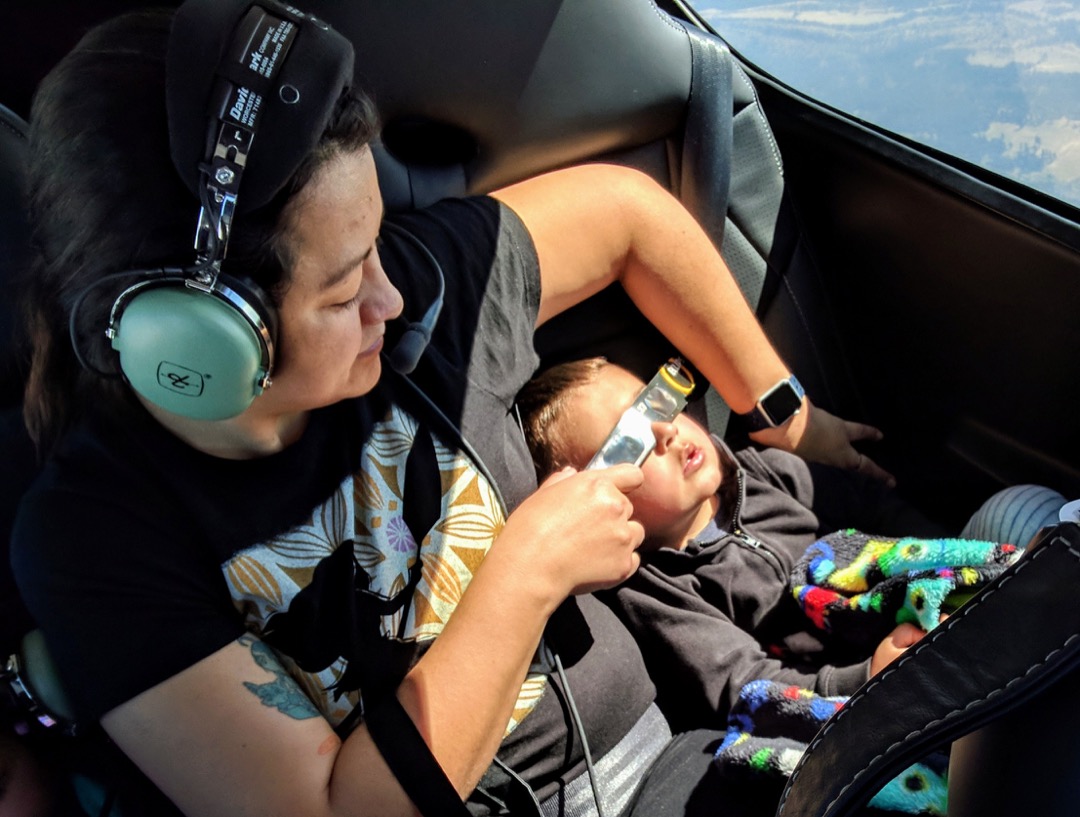
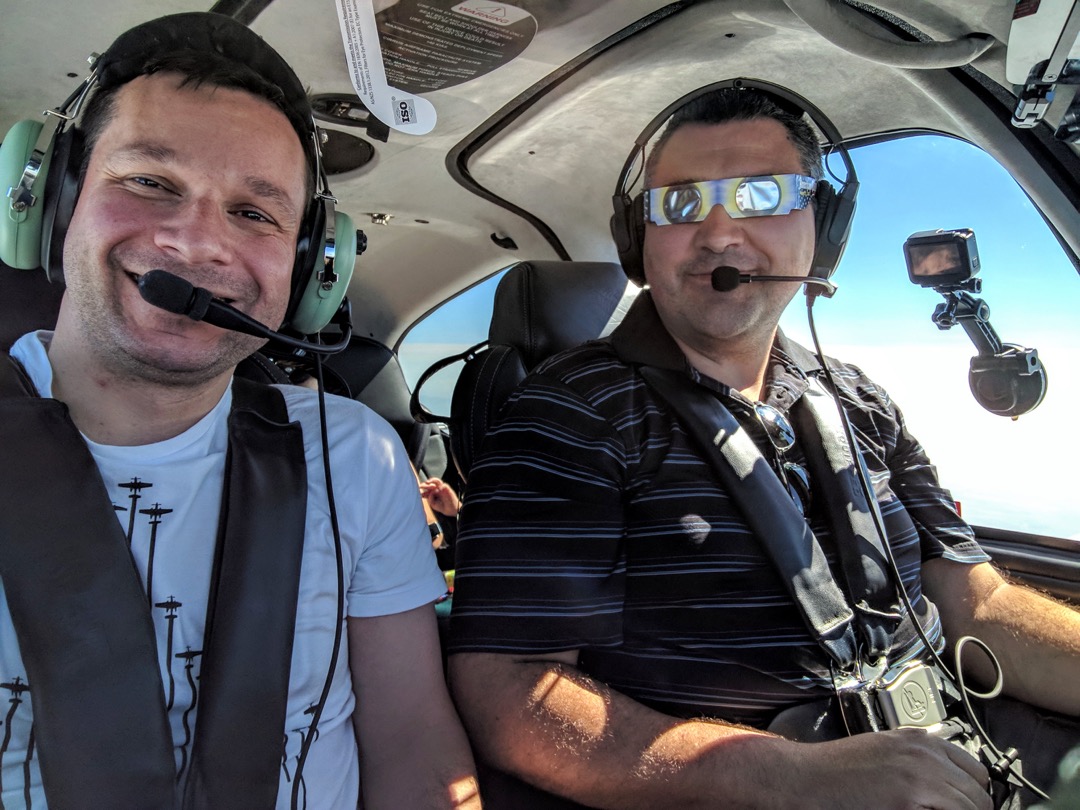
Around 10:18am or so, we could see the shadow sweeping the ground from the west and everything becoming really dark, except for the horizon, that was still as bright as any sunset or sunrise. It’s super easy to spot traffic in the dark, so we were a bit less concerned. There was nobody unsafely close to us and we had all possible lights on. I disconnected the autopilot and did some steep turns, so we all could get a very good view of the sun, that was about 40 degrees above the horizon. It’s hard to describe how beautiful the whole thing is from above. It really looks like a sunset, when the sun is a couple degrees below the horizon, with the caveat that it’s the same gradient of colors throughout the entire horizon. It’s so sad it lasted only 2 minutes. We could see the shadow moving away at tremendous speed to the east. Suddenly, everything was super bright again. The show was over.
We didn’t waste any time. We hit direct-to Klamath Falls in the navigator and left the area immediately at full cruise speed, with all eyes outside watching for traffic. We could see in the screens that everybody was doing the same. At 170 knots, we left all small planes behind very quickly. We landed back in Klamath Falls around 11:30am. There was a restaurant in the airport, so we took a couple hours there, as there was no rush anymore. Lots of airplanes landed after us.
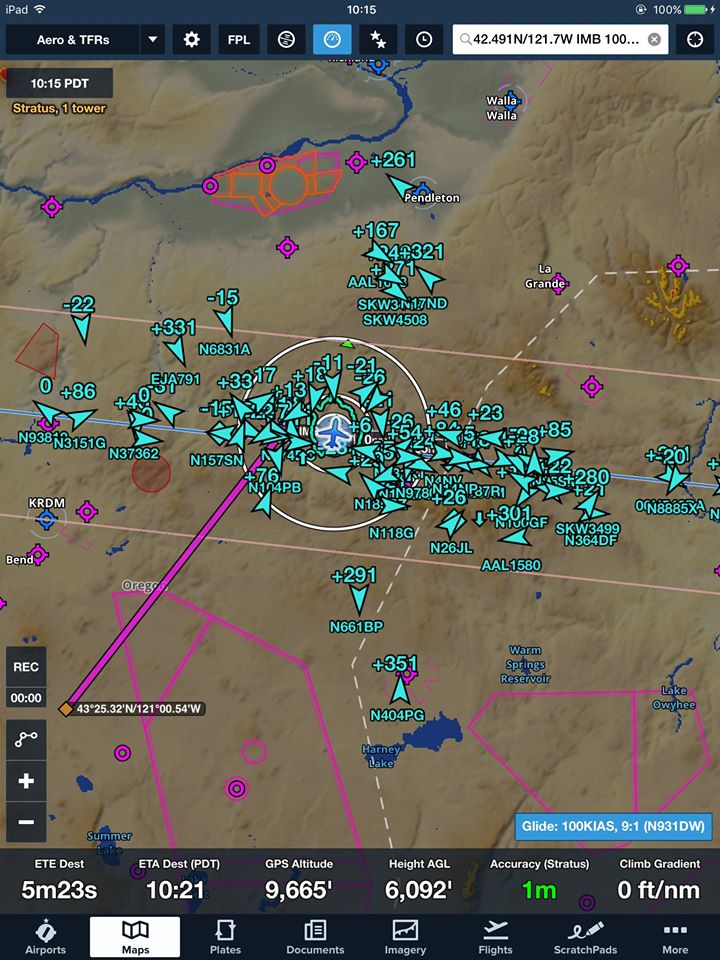
We took off back to Hayward 2:13pm. The traffic was still very intense, so we decided to fly on an instrument flight plan, even though it wasn’t actually necessary. When flying instruments, you have all possible air traffic control services and they’re responsible for your navigation. They have a better picture of the whole traffic situation. ATC vectored us around during the entire flight to keep us safely away from others. We landed safely in Hayward 4:11pm. Luana went home with the kids and Alberto and I repositioned the airplane to San Carlos, its home base, in a very short 7-minute flight across the bay. I logged 8.4 hours on that day, the longest I’ve ever done in one day.
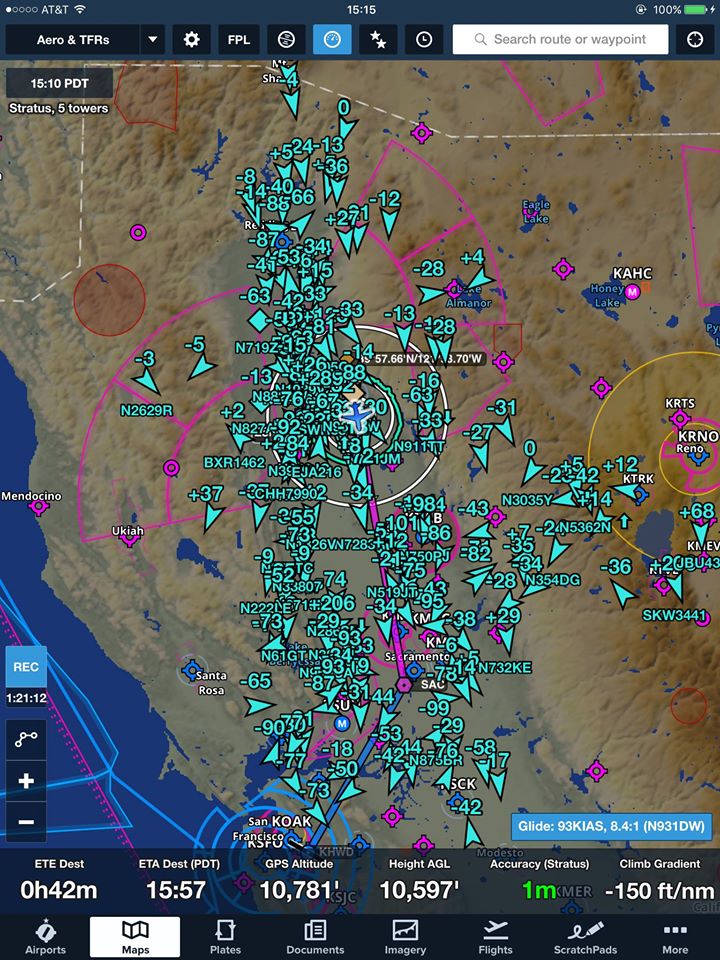
When I tied the airplane down and closed everything, I called the mission accomplished. I had been planning this day for so long. The plan had so many moving pieces and things to go wrong. We were able to pull it off perfectly, adding something magnificent to our bag of experiences.
I’ll never forget that special day.
Big thanks to my friend Alberto for serving as our co-pilot and helping me execute this mission safely. And a special thanks to JATO Aviation, for the spectacular instruction and trusting me with the best of their fleet.